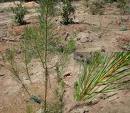Pinus Attenuata Tree Information
Images of Pinus Attenuata:






Pinus Attenuata grows in the following 4 states and provinces:
California, Colorado, Maine, OregonInformation about Pinus Attenuata:
as well ashe Pinus Attenuata is commonly known as the Knobcone Pine.
The currently accepted scientific name of knobcone pine is Pinus attenuata Lemm. . There are no subspecies or varieties. The distributions of knobcone and Monterey (P. radiata) pines overlap in Santa Cruz County, where they produce the hybrid P. X attenuradiata Stockw. & Right . Knobcone pine is the most widely distributed of the West Coast closed-cone species. Discontinuous populations occur from southwestern Oregon south through the Klamath, Cascade, and Coast ranges and the Sierra Nevada. Stands in the South Coast Ranges are widely disjunct, occurring in the Santa Ana and west San Bernadino mountains, at Cuesta Pass, San Luis Obisbo County, and near Encinada, Baja California .The knobcone pine community occupies a transitional position between chaparral and woodland and higher elevation forests. Because of its patchy distribution, it is usually surrounded by other communities. At lower elevations, it is most often associated with chamise (Adenostoma fasciculatum)-manzanita (Arctostaphylos spp.) communities and various oak (Quercus spp.) woodlands. At higher elevations, it is associated with a variety of coniferous communities (see SAF Cover Types) . Within the knobcone pine community, the pines are usually widely spaced. The community is sometimes described as woodland rather than as forest . On favorable sites, knobcone pine forms dense, even-aged stands or dwarfed thickets. Understory herbaceous species are usually fire-followers and endemics. Shrubs occur individually or in small patches between pines. Mosaics of chaparral, woodland, knobcone pine, and other coniferous forests sometimes occur due to topographical and substrate differences . Publications listing knobcone pine as a dominant species are as follows: Vegetational types of the San Bernadino Mountains Vegetation of the San Bernadino Mountains A vegetation classification system applied to southern California Mixed evergreen forest Vegetation of the Siskiyou Mountains, Oregon and California An introduction to the plant communities of the Santa Ana and San Jacinto Mountains The closed-cone pines and cypresses Some of the information provided here is attributed to:Howard, Janet L. 1992. Pinus attenuata. In: Fire Effects Information System, [Online]. U.S. Department of Agriculture, Forest Service, Rocky Mountain Research Station, Fire Sciences Laboratory (Producer). , available at the USDA Fire Effects Information System (FEIS) website